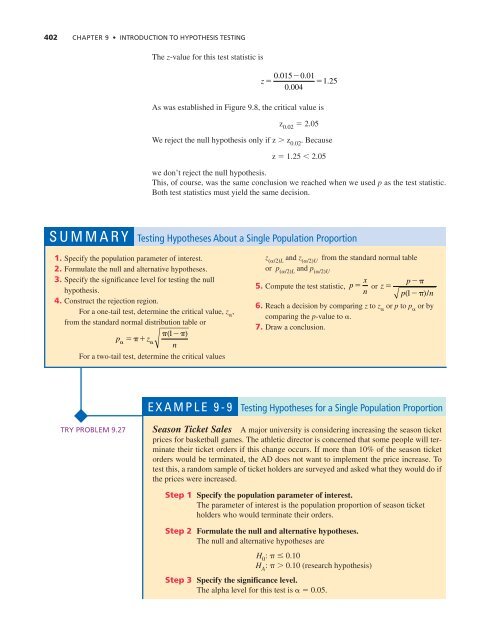Chapter 9: Introduction to Hypothesis Testing
Chapter 9: Introduction to Hypothesis Testing
Chapter 9: Introduction to Hypothesis Testing
You also want an ePaper? Increase the reach of your titles
YUMPU automatically turns print PDFs into web optimized ePapers that Google loves.
402 CHAPTER 9 • INTRODUCTION TO HYPOTHESIS TESTING<br />
The z-value for this test statistic is<br />
0. 0150.<br />
01<br />
z <br />
125<br />
.<br />
0.<br />
004<br />
As was established in Figure 9.8, the critical value is<br />
z 0.02<br />
2.05<br />
We reject the null hypothesis only if z z 0.02<br />
. Because<br />
z 1.25 2.05<br />
we don’t reject the null hypothesis.<br />
This, of course, was the same conclusion we reached when we used p as the test statistic.<br />
Both test statistics must yield the same decision.<br />
SUMMARY <strong>Testing</strong> Hypotheses About a Single Population Proportion<br />
1. Specify the population parameter of interest.<br />
2. Formulate the null and alternative hypotheses.<br />
3. Specify the significance level for testing the null<br />
hypothesis.<br />
4. Construct the rejection region.<br />
For a one-tail test, determine the critical value, z <br />
,<br />
from the standard normal distribution table or<br />
p ( 1)<br />
z<br />
n<br />
For a two-tail test, determine the critical values<br />
z (/2)L<br />
and z (/2)U<br />
from the standard normal table<br />
or p (/2)L<br />
and p (/2)U<br />
x p<br />
5. Compute the test statistic, p or z <br />
n p( 1)/<br />
n<br />
6. Reach a decision by comparing z <strong>to</strong> z <br />
or p <strong>to</strong> p <br />
or by<br />
comparing the p-value <strong>to</strong> .<br />
7. Draw a conclusion.<br />
EXAMPLE 9-9<br />
<strong>Testing</strong> Hypotheses for a Single Population Proportion<br />
TRY PROBLEM 9.27<br />
Season Ticket Sales A major university is considering increasing the season ticket<br />
prices for basketball games. The athletic direc<strong>to</strong>r is concerned that some people will terminate<br />
their ticket orders if this change occurs. If more than 10% of the season ticket<br />
orders would be terminated, the AD does not want <strong>to</strong> implement the price increase. To<br />
test this, a random sample of ticket holders are surveyed and asked what they would do if<br />
the prices were increased.<br />
Step 1 Specify the population parameter of interest.<br />
The parameter of interest is the population proportion of season ticket<br />
holders who would terminate their orders.<br />
Step 2 Formulate the null and alternative hypotheses.<br />
The null and alternative hypotheses are<br />
H 0<br />
: 0.10<br />
H A<br />
: 0.10 (research hypothesis)<br />
Step 3 Specify the significance level.<br />
The alpha level for this test is 0.05.

















